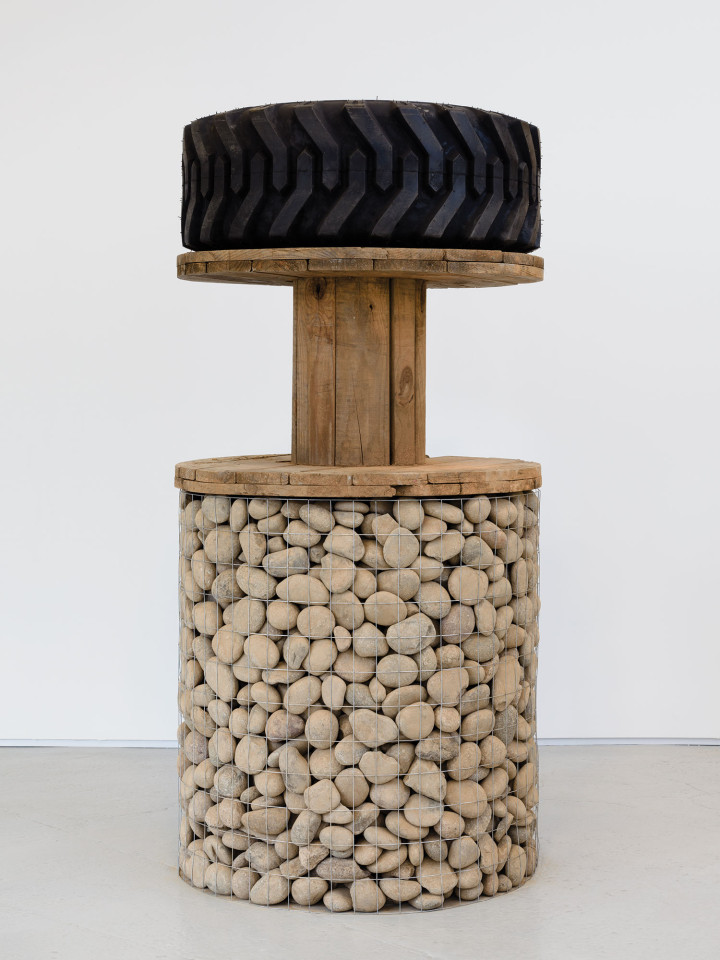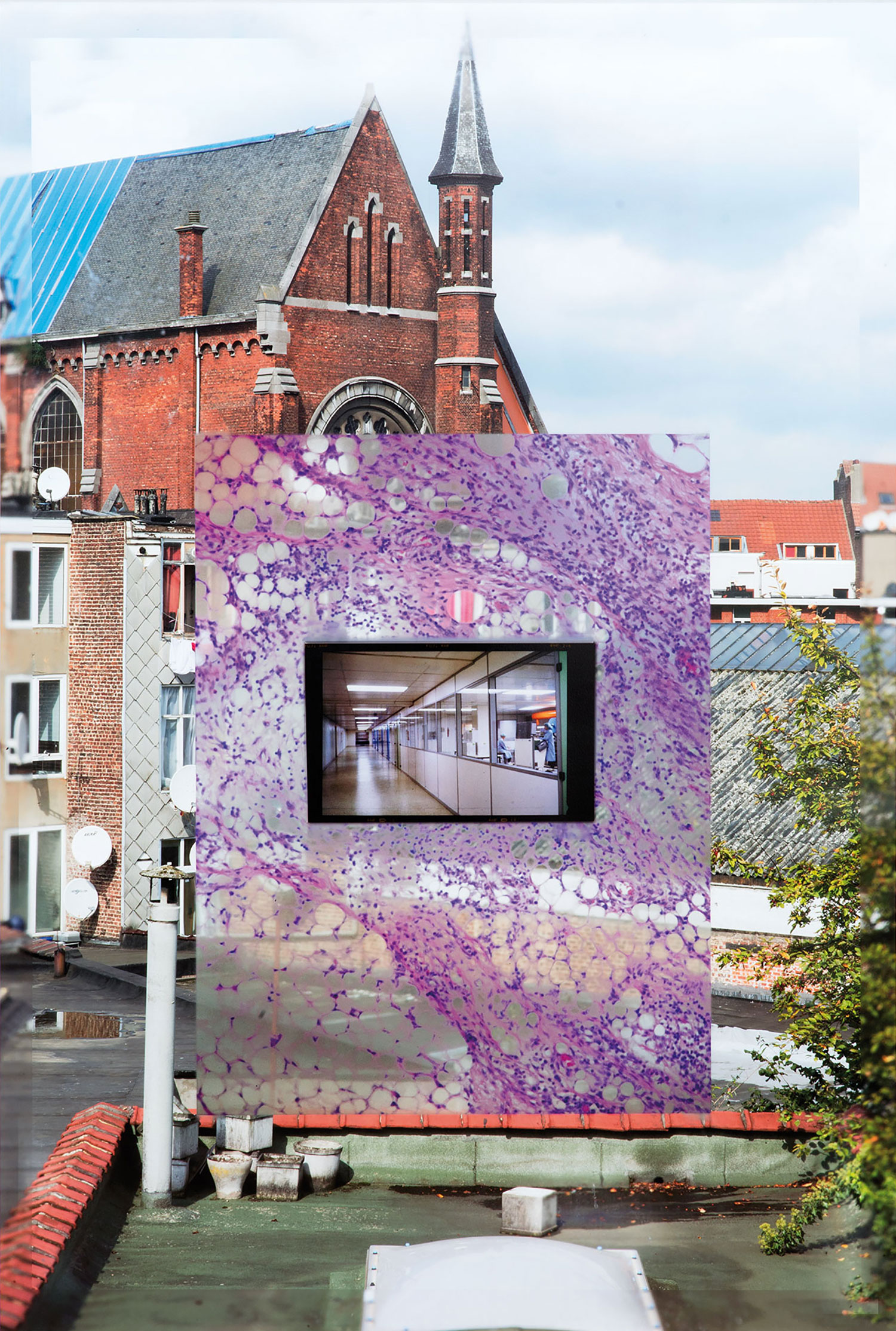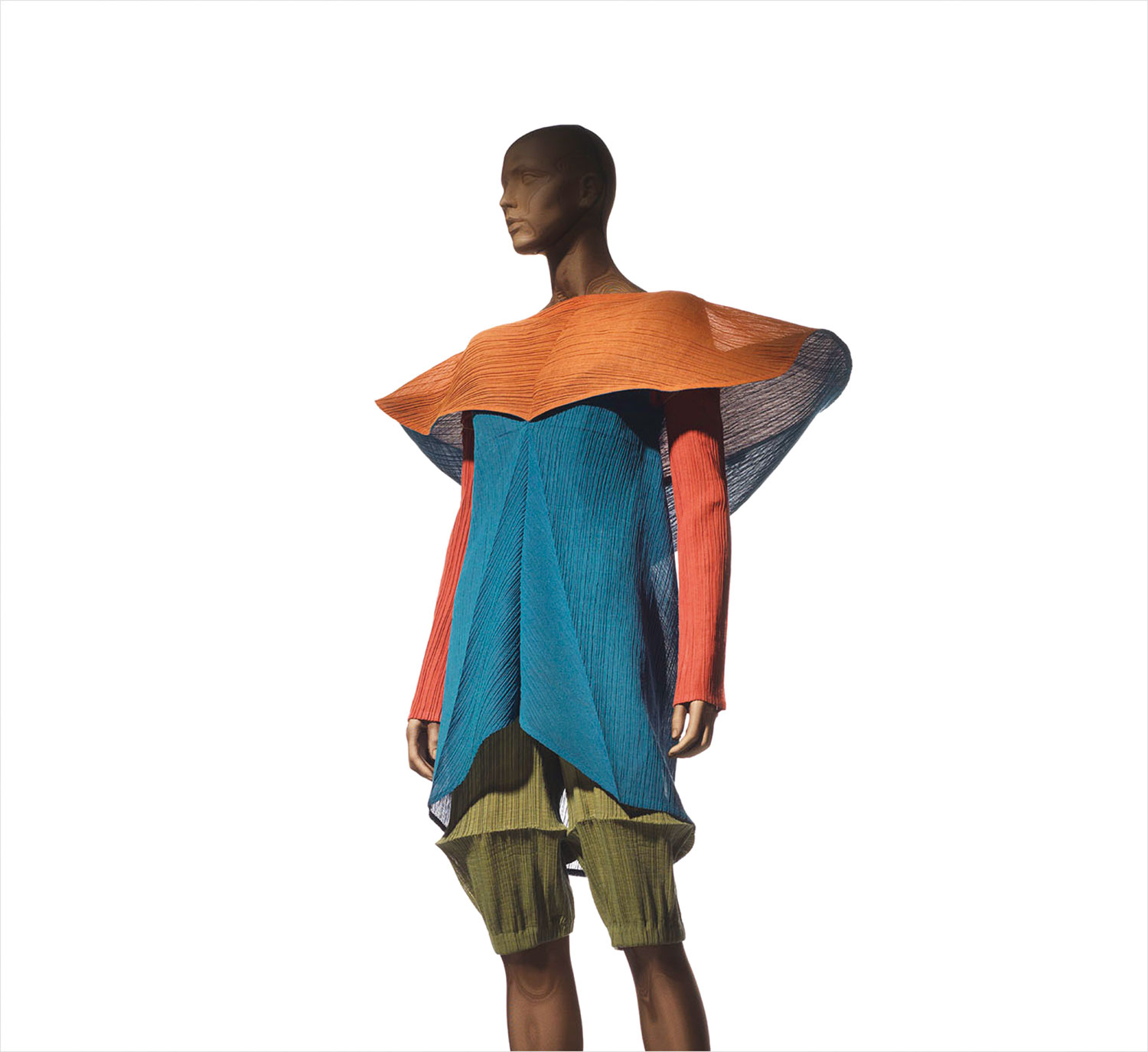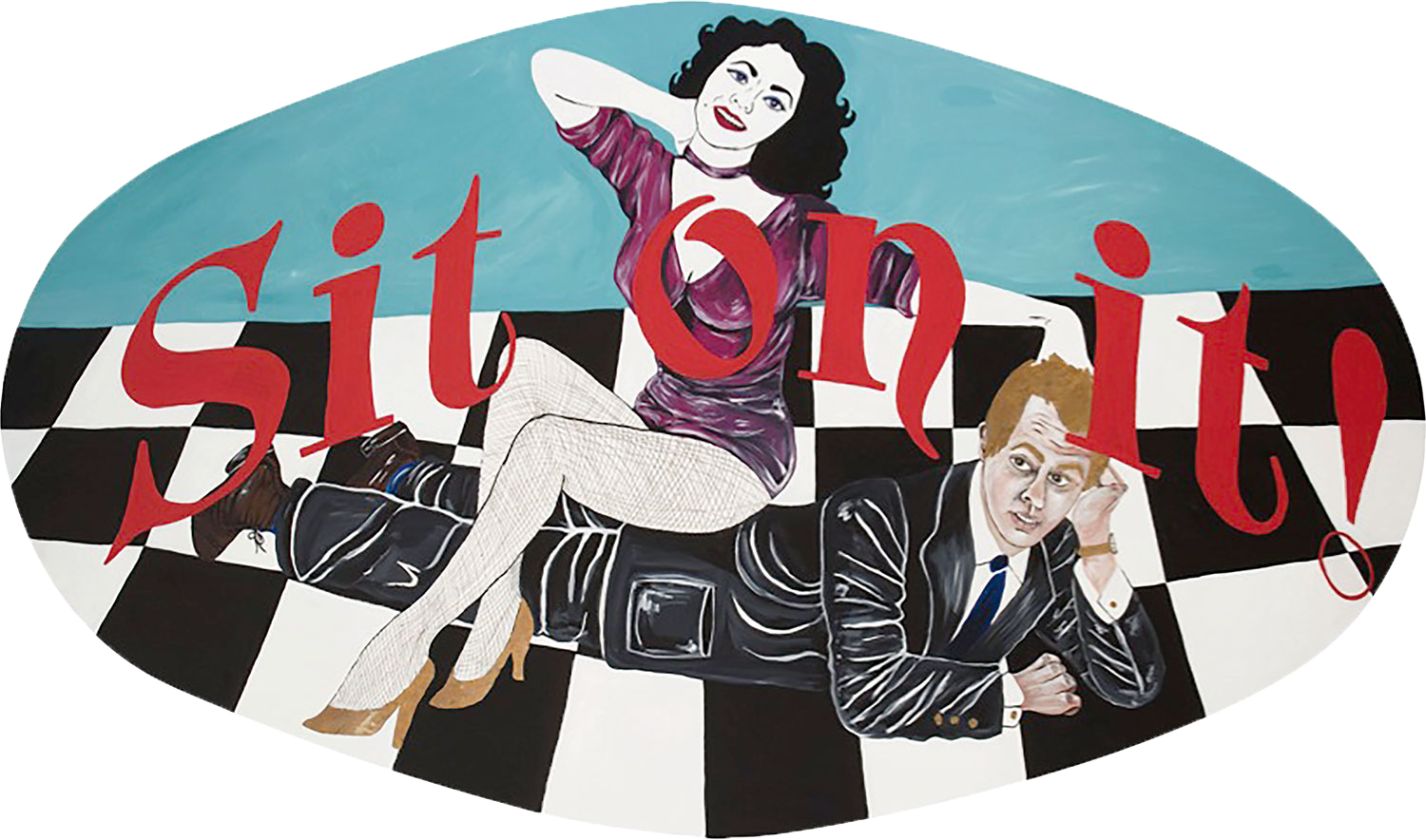
Carol Bove: Can we talk a little about this tree piece [from the series “Tree”] in your studio right now?
Charles Harlan: Sure, it’s a fence post I found in Dogtown in St. Louis. A friend told me there were a few places near his house where trees are growing up through fences, and he thought it would be easy for me to take one. I have several pieces like this, where a tree grows into another object and absorbs it.
So I got up early one morning and drove to St. Louis in my truck, straight to where this post was located. There were five of them standing along the road. When I saw this one it looked just like it does now in my studio. Some vines and limbs had wrapped around the post and almost completely covered it. There are bits of chain link and barbed wire sticking out the sides. Someone else, probably years ago, removed the chain link fencing, but for some reason they left the posts in place. I cut it down, threw it in the back of my truck, and drove back to New York.
CB: It’s amazing. Is it for your show in Brussels [at Galerie Rodolphe Janssen]?
CB: Yes, I was thinking of calling the show “Menhirs,” after Neolithic standing stones. Most of the sculptures in the show are inspired by ancient forms, and they’re all sort of pillar shaped.
CB: What was that book you were telling me about earlier, about a new theory of megaliths?
CH: It’s called Image and Audience by Richard Bradley. It isn’t so much a new theory of megaliths as it is a different way to think about ancient art and the people who made it. I read it because it elaborates on how I think of ancient artworks. The basic idea is that when we think about Neolithic humanity we tend to consider their artifacts and architecture as utilitarian. The book suggests that this way of thinking is short selling our ancestors and their capacity for abstract thought — like maybe Machu Picchu is a giant earthwork or sculpture garden.
CB: Do you think the present affects the past?
CH: This reminds me of a conversation you and I had recently after seeing The Hobbit. At the bar after the movie we were Googling around trying to make sense of the continuity flaws in the newer prequels relative to the original trilogy when we came across the word “retcon.” This is the perfect word to describe the present’s effect on the past. It means retroactive continuity, and it’s all over the great sci-fi and fantasy franchises that we grew up with, like Star Wars and Star Trek. The idea is that in order to make space for prequels or sequels, it may be necessary to alter already established facts in the narrative. Like, why wouldn’t Obi Wan remember R2D2 in A New Hope if he knew him in the prequels, or something like that? If you think of the past as our own prequel, we are constantly having to alter it to make sense of not only our own personal narratives, but culture’s narrative too.
It might be due to humanity’s compulsion to turn existence into a story, rather than just experience it. In sci-fi it’s a retcon, in relationships it’s a white lie, in politics it’s propaganda, and in history it’s revisionism. Thanksgiving and Columbus Day are retcons. All of Christianity as we understand it today is built on the retcon that is the Council of Nicaea!

CB: Right, the retcon! I must have had that in the back of my mind when I asked that. Here’s another question that is a little disconnected but I’ve been curious about this for a while: Did your interest in conspiracy theories develop out of your interest in politics or is it just holding the same place in your mind?
CH: I minored in politics in college, and was really interested in the system. Living through two Bush elections was brutal, especially considering he lost the first one. Then in 2008 I was excited for Obama. But like many people, I quickly became disillusioned. It was, “Meet the new boss, same as the old boss.”
And I realized Tweedle Dee and Tweedle Dum agree to have a battle. If you step back from the rhetoric it’s pretty obvious that the two parties employ a divide and conquer strategy. We argue about various social issues amongst ourselves while the wars continue, and the financial bilking continues at our detriment. Just the idea that the entire spectrum of political beliefs and ideologies must be narrowed down to a choice between two major parties in this country is completely absurd. Conspiratorial thinking didn’t replace an interest in politics; it came with a deeper understanding of the way power operates in America. Also, I read the Illuminatus! Trilogy and had a UFO sighting. So it was pretty much inevitable.
CB: Is this all in the service of the politicians or are they working for someone?
CH: The military industrial complex and international financial interests. But it’s not like the politicians are doing this covertly. They are former corporate attorneys, bankers, defense and intelligence contractors. It’s all very overt, but people get caught up in social issue rhetoric and we don’t realize they’re all on the same team.
It reminds me of how Aspartame was approved by the FDA. Searle invented the sugar-free sweetener in the 1970s and wanted to use it for diet sodas. However, at the time, the FDA refused to approve it because their scientists said it causes brain tumors and cancer.
When Ronald Reagan was sworn in as president, the head of his transition team was Donald Rumsfeld. At the time, Rumsfeld was the CEO of Searle, and said he would “call in my markers” to get aspartame approved. On the day after Reagan’s inauguration he issued an executive order that led to the sweetener’s approval, one of his first acts as president. When Monsanto bought Searle they gave Rumsfeld a huge bonus, and he later went on to be the Secretary of Defense under George W. Bush during the early days of the War on Terror. The politicians are all working for themselves at our expense. That’s really the whole conspiracy.
CB: Do you think you need any background information to understand your sculptures?
CH: It seems like this is a central question that all artists deal with. I have my own sort of ecosystem that informs my work, or inspires it. But for me it’s important to remember that I’m not writing a thesis or a blog or something. Sculpture is communication, but it’s visual and abstract like poetry or traffic signs. Some sculpture requires too much explanation.
My work is informed by whatever thing I’m thinking about at the moment, but I try to make it approachable beyond these specific references. This is why a sculpture may look like whatever art-historical figure I’m ripping off, or an architectural form I’m interested in, but that isn’t the only reading. My interest in astro-archaeology and myth informs my work as well. But no single reading trumps another. An understanding of those references could only enrich an experience with mine, or anyone’s work, but I hope for it to be unnecessary.
I was talking with a friend the other night about this exact question and he said that he doesn’t understand his best work. And I think that’s a good thing to aspire to. I feel like I got into art because I didn’t want to explain myself.
But how do you answer this question for yourself? I know that a ton of research and so many references go into all of your sculptures. Reading them can be as specific as a viewer wants to make it, but I feel like your sculptures are approachable beyond your specific brand of thinking.

CB: When I was first making things in the early 1990s, I took the Chris Burden method to be the standard operating procedure for exhibiting sculpture. (For those not familiar, he would write a description of the materials and process on his wall labels, for example, Porsche with Meteorite (2013). Restored 1974 Porsche 914 with 365-pound meteorite, steel frame. Dimensions: 13 ft 6 in x 38 ft 9 in x 13 ft 6 in; car: 3ft 11½ in high x 13 ft 6 in long x 5 ft 4 in wide, weight: 2,190 lbs; meteorite: 15 x 17 x 15 in, weight: 365 lbs; steel structure: 13 ft 6 in x 35 ft x 6 ft; 5,025 lbs total). This strategy allows the artist to frame the object with some context and give the viewer a vector of approach, but the description underscores the fact of the object since it is offered as an explanation. At Chris Burden’s New Museum retrospective, the wall labels struck me as idiosyncratic. They made me see his work in relation to artists who were working more deliberately with display strategies as material. I think the challenge is to talk about one’s work and make it accessible without undermining its basic indefensibleness. These days I’d rather people didn’t have any background information about my work. I just want them to see the work in person. How much does your work depend on its context?
CH: I like how you describe Burden’s descriptions. That seems like a good way to contextualize a sculpture without revealing the man behind the curtain. I’m the exact opposite with my descriptions — preferring the general over the specific. I’ll refer to a piece of steel remesh as simply “steel.” I like a little bit of obfuscation. I think it allows for more diverse interpretations. My remesh pieces are a good example of my approach to background information. Referring to them as simply steel and concrete plays on the fact that many people have no idea remesh is a readymade, functional object. Unless you are a contractor or sculptor, you may have never encountered remesh in the wild. With these sculptures the tool slips in unseen and puts on an aesthetic show. These pieces suspend objects that are usually hidden beneath the concrete. The ordinarily esoteric element is displayed in plain sight, and it still somehow manages to remain mysterious. This, to me, is a good metaphor.
The challenge you outlined of trying to preserve a work’s indefensibleness could be my mantra! I’m constantly trying to talk circles around my work without revealing that I have no idea what it’s about. It is indefensible. Maybe we shouldn’t even print this…
The question of context is very important to me. It’s an unavoidable subject when you flirt with the readymade. So many of the art experiences I have are with non-art objects I stumble onto in Red Hook’s industrial areas, or in an empty suburb at night. The tree pieces I’ve been making recently are literal recontextualizations of objects I found in the street. Seeing them around New York is just as powerful to me as seeing them on a gallery wall, and that’s a feeling I want to re-create with my work — a confusion between a useful object and an art object. I feel like that’s the question of the pyramids — if they are art or not.
CB: You fish a lot, and I’ve wondered if it provides a context for your work. Does it make you a better artist?
CH: I think fishing makes me a worse artist! It competes for my attention and makes me tired. Instead of thinking about smart things, I’m busy thinking about bait and moon phases and whatever tool I need to buy. But as you’ve mentioned in your past writing, you have a weird obsession with self-help books. In one of your favorites, The Artist’s Way, the author recommends doing something unrelated to your art that turns you on. I think fishing takes that place for me.
Fishing is all about deception. I’ll stand for hours by a stream throwing spinners and poppers trying to get inside a fish’s head. Thinking of where they are hiding, how to move the line or which colors and angles might work. It gets very abstract — hours of non-verbal communication with an alien species. Maybe it clears my mind, but it definitely leads me to miss a lot of art stuff.
I certainly don’t have any sculpture-related epiphanies while I’m out there, but it gives me the energy to deal with the art events. A lot of people like surfing these days. In fact, it’s all I hear about! What do you do to get away from art stuff?

CB: I have so many things that distract me from my “real” work or studio time or however you want to think about it. If you were to remove the extraneous activity there would be nothing left. I’m very confused about what “studio time” is, and the confusion led me back into Zen Buddhism recently after years of not practicing. There’s a passage from The Three Pillars of Zen about koans that reminds me of what you said about explaining your sculptures. Koans are stories or questions used in Zen Buddhist tradition to induce doubt and subvert a monk’s reliance on reason. Koans take as their subjects tangible, down-to-earth objects — such as a dog, a tree, a face, a finger — to make us see, on the one hand, that each object has absolute value and, on the other, to arrest the tendency of the intellect to anchor itself in abstract concepts. The import of every koan is the same: that the world is one interdependent whole and that each separate one of us is that whole.
I like the analogy of the koan because your work seems uninflected and opaque, but I presume it isn’t the product of deliberate encryption.
CH: I’m really glad you brought up koans, because you’ve put into a word what I was thinking. What is powerful about the koan is that it embodies both micro and macro at the same time. I feel like many of my sculptures could be infinitely scalable. I like thinking of sculpture as able to operate in miniature or at the scale of geology. Thinking of sculpture as it relates to the human body is to accept a limited perception.
My favorite koans are the ones that end with some poor monk getting slapped. Because so much of Zen relies on negating learned understanding, we have to ask the master what is left after everything has been negated. The master replies with a slap, which is neither affirmation or negation, but pure experience and pure understanding. The slap is a way to break through mediated experience into enlightenment, which seems like a good aspiration for art making. I’d hate to be so presumptuous as to compare my sculptures to Zen koans, but it’s definitely what I’m striving for.
CB: It’s interesting that it’s hard to talk about mysticism in art. I used to think it was because the art audience is prejudiced against it, but I’m starting to think it’s more that communicating about gnosis verbally has a tendency to denature the experience.
CH: I agree. I think talking about mysticism in general is difficult, not because of a prejudice against it, but because most of that stuff isn’t supposed to be put into words. It’s like the slap in the koan. When words and facts get mixed up you have to drop the words and rely on the facts.





